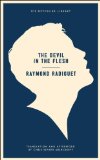Those who study literary theory view World War I as a key element in the development of modernist literature. And while French author Raymond Radiguet published only one novel before his death at age 20, that work, The Devil in the Flesh, is a prime piece of evidence for this viewpoint.
 It’s not surprising that Radiguet’s book caused a stir when it was published in 1923. Set in the Paris suburbs during the last year of World War I, The Devil in the Flesh tells the story of a 16-year-old boy, the narrator, who has an affair with and impregnates the 18-year-old wife of a French soldier while the soldier is at the front. Although the age of consent in France at the time was 13, the thought of a teen’s betrayal of a fighting man would still chafe. What perhaps bolstered the distress of readers is the knowledge there were more than a few wives who cheated on their soldier husbands and gave birth to illegitimate children. In fact, the book is semi-autobiographical. Radiguet supposedly started writing it between the ages of 16 and 18 after having had an affair with the wife of an soldier at age 14.
It’s not surprising that Radiguet’s book caused a stir when it was published in 1923. Set in the Paris suburbs during the last year of World War I, The Devil in the Flesh tells the story of a 16-year-old boy, the narrator, who has an affair with and impregnates the 18-year-old wife of a French soldier while the soldier is at the front. Although the age of consent in France at the time was 13, the thought of a teen’s betrayal of a fighting man would still chafe. What perhaps bolstered the distress of readers is the knowledge there were more than a few wives who cheated on their soldier husbands and gave birth to illegitimate children. In fact, the book is semi-autobiographical. Radiguet supposedly started writing it between the ages of 16 and 18 after having had an affair with the wife of an soldier at age 14.
Yet the sordid touch added by the narrator’s age and the betrayal of a soldier are not the only elements that can disturb. The narrator (unnamed in many translations but called Francois here in Christopher Moncrieff’s translation) observes in the first paragraph, “People who reproach me should try and imagine what the War was for so many young boys — a four-year-long holiday.” Certainly, those who experienced the War — capital W — or its ramifications didn’t see something that took the lives of nearly 1.4 million French soldiers as a holiday. Add to this that Francois comes off as little more than an amoral narcissist and there’s plenty to outrage.
At the outset of The Devil in the Flesh, Francois is what readers today would essentially classify as a teenager with the attitude of that age. His sexual desires and drives, although not specifically denominated as such early in the book, have become far more common among literary characters over the decades. When he first meets 18-year-old Marthe Lascombe, the daughter of a family friend, her fiancé is on the front lines. Francois fosters his relationship with her by helping her pick out items for her future household. It is only after her marriage, though, that he eventually manipulates her into a sexual relationship. Yet Francois eventually falls deeply in love with Marthe, at least insofar as he can conceive of the emotion
Throughout the book, the dialog and perspective are internal. Francois is focused on his feelings and his emotions. Only occasionally does he show care or concern for Marthe and even then it tends to be short-lived. Yet there is no doubt he has some internal conflicts and Francois often seems a blend of naiveté and hedonism. He wants to flaunt society’s rules but often oscillates between the effort to shock and an effort to hide the relationship. He repeatedly praises love yet even then does so in a tone mental heals professionals would call affectless. He is not unaware of a certain inherent level of immaturity while engaging in an adult game. “We were like children standing on a chair, proud of being taller than the grown-ups,” he says. “Circumstances put us in this lofty position, but we were unable to live up to it.”
As Radiguet’s sparse, direct prose leads the work to its tragic conclusion, it is easy to see why The Devil in the Flesh is considered emblematic of early 20th Century modernism. The book does not carry the same shock value as it did on its initial release. Yet that does not prevent it from being a precursor to several themes that would be explored in coming decades or change the fact many of those same themes and issues remain relevant today.
Happiness thinks only of itself.
Raymond Radiguet, The Devil in the Flesh







